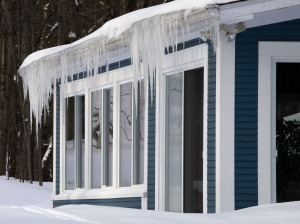
02 Nov How to Avoid the Dreaded Ice Dam
 As winter approaches, homeowners should consider taking steps to avoid ice dams, which have the potential to cause serious damage to your home.
As winter approaches, homeowners should consider taking steps to avoid ice dams, which have the potential to cause serious damage to your home.
We’re all familiar with the picturesque sight of rows of glistening icicles hanging from the roofline of homes, but did you know those icicles are a symptom of a potentially dangerous and expensive problem?
Ice dams are ridges of ice that form near the edge of a roof, and cause water to build up behind them rather than draining properly. These ice formations frequently cause water to leak into the home, resulting in stained ceilings, damaged insulation, wallboard or plaster, and the growth of mold. Roof shingles and gutters can also be damaged by this unwanted ice.
In order to avoid ice dams, it helps to understand the basic causes of this cold weather phenomenon. Ice dams occur following the accumulation of snow on the roof, but are much more likely to occur when certain conditions exist in a given home. If the attic and roof of your home lack proper insulation, portions of the roof become warm enough to melt the snow. The overhanging portion of the roof remains below 32 degrees, and the water runs down the roof, forming a growing ice dam in the gutters and at the edges of the roof.
Ice dams can be prevented in new construction with the proper insulation and by making the ceiling air tight to prevent warm, moist air from flowing out of the house into the attic. A good builder will also make sure that exhaust systems for kitchens or bathrooms, and chimneys for wood stoves and fireplaces don’t contribute to the creation of ice dams.
“This is just one of the many things we consider as we build a home,” said Grasso Development President Jeffrey Grasso. “Understanding how ice dams occur, and how to avoid them allows us to save our clients the hassle and expense that ice dams cause.”
Grasso said that owners of older homes can take steps to reduce or eliminate the risk of ice dams as well. “We can add insulation and seal areas where warm air may be escaping from the home to the attic. We can also address the problem of poorly insulated duct work and poorly designed exhaust systems.”
Many homeowners fail to take these preventative steps, and are forced to take far less desirable actions once winter is upon them. When you know you are susceptible to ice dams, it is important to clear snow from the roof, particularly when extended periods of freezing weather are expected. Unfortunately, it is difficult, if not impossible, for the homeowner to safely remove snow from the roof on his own. Climbing a snowy ladder with a roof rake is risky business, and incidents of homeowners being knocked off ladders by falling snow and ice are frequent.
Ice dams can be eliminated after they occur by professionals, but this is expensive and far less desirable than preventing them in the first place.
Homeowners should also take steps to keep their gutters and downspouts clear to allow water to leave the roof unobstructed. Gutters should be cleaned of leaves and other debris frequently, especially after the leaves have fallen, but before winter has begun.
Grasso Development addresses the issues that lead to the formation of ice dams when building fine custom homes. If you have questions about ice dams and the steps you can take to prevent them, or for other information about custom home building or renovations in the Westchester, NY area, call Grasso Development at (914) 632-0525.